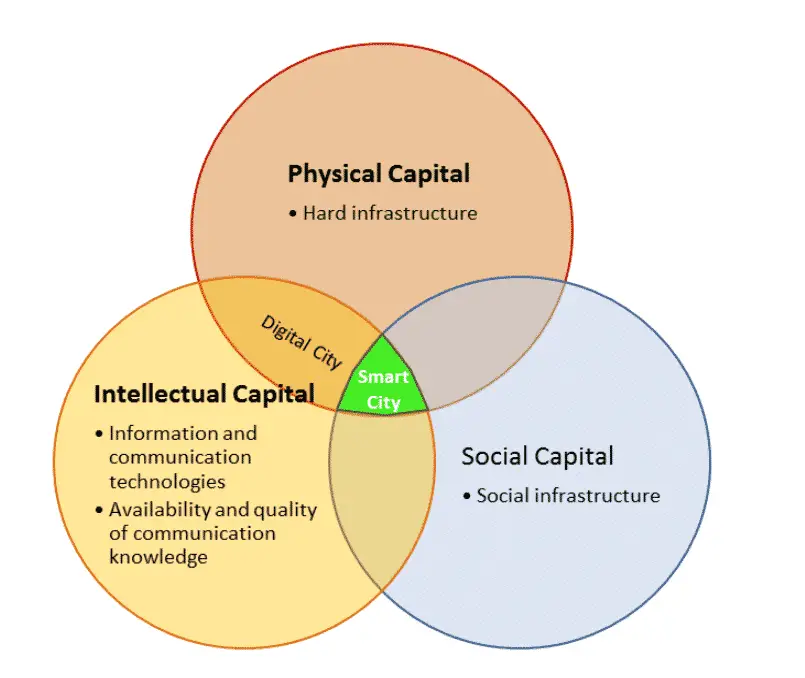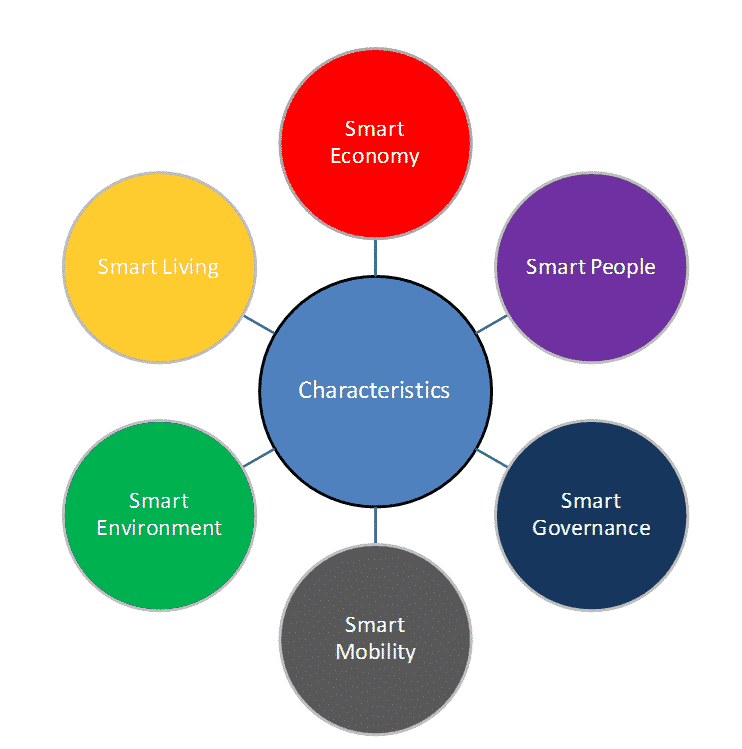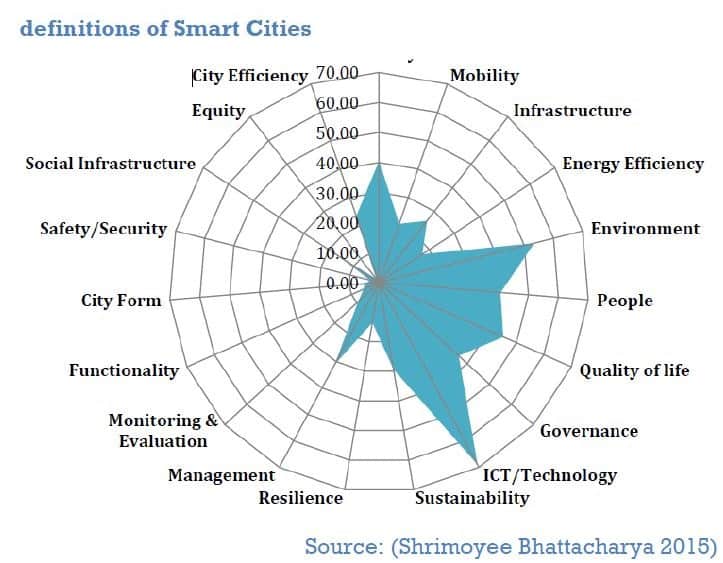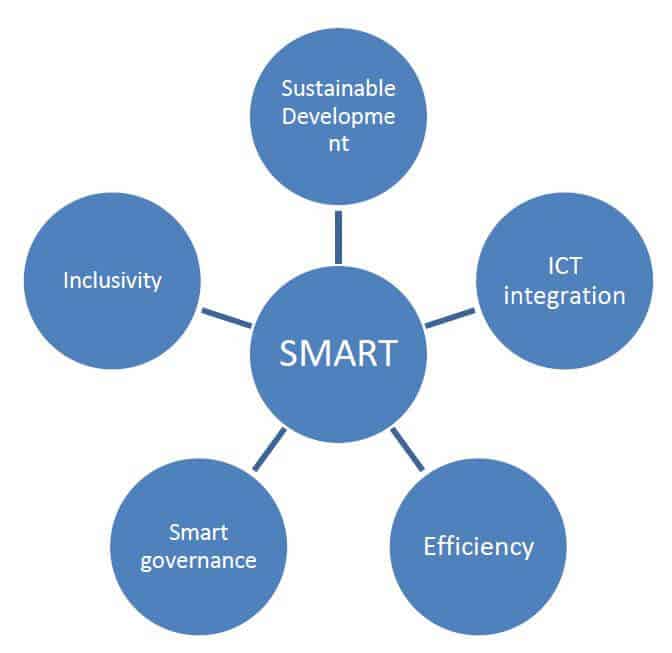What is Smart City concept?
The concept of Smart City is a relatively new idea which has been fast gathering momentum and is becoming the theme of many development plans and seminars. The definition and features which constitute a smart city concept is still very much debatable, however, since it has been part of several studies there are some key aspects which can be used to describe a smart city.
There is no universally accepted definition of a Smart City. It means different things to different people. The conceptualization of Smart City, therefore, varies from city to city and country to country, depending on the level of development, willingness to change and reform, resources and aspirations of the city residents. A Smart City would have a different connotation in India than, say, Europe. Even in India, there is no one way of defining a Smart City. In the approach to the Smart Cities Mission, the objective is to promote cities that provide core infrastructure and give a decent quality of life to its citizens, a clean and sustainable environment and application of „Smart‟ Solutions. The focus is on sustainable and inclusive development.

A city can be defined as a “smart city” when investments in human & social capital, traditional (transport) and modern (ICT) communication infrastructure together fuel sustainable economic development and a high quality of life, with a wise management of natural resources. It is considered to be the next step in urbanization. A smart city essentially implies an efficient city.
Contemporarily it was stressed on physical capital for developing cities but two new order capitals have acquired important seats in the sustainability of cities. Smart City stresses on the three capitals and integrates them into a common framework to form a more sustainable, competitive environment. Smart cities are formed through the interaction of Physical Capital, Social Capital and Intellectual Capital.

An urban area that creates sustainable economic development and high quality of life by excelling in multiple key areas such as economy, mobility, environment, people, living, and governance can be called a smart city.
Evolution of smart city concept
1992 – Smart Growth-this concept proposed that the concentration of growth in a city takes place in compact (mixed use) and walkable urban centers (range of transportation and housing options) where a community participates in making development decisions that are fair, predictable and cost effective.
2000- A city that monitors and integrates conditions of all of its critical infrastructures, including roads, bridges, tunnels, rails, subways, airports, seaports, communications, water, power, even major buildings can better optimize its resources, plan its preventive maintenance activities and monitor security aspects while maximizing services to citizens. (E 2000)
2004- A city where ICT strengthens the freedom of speech and accessibility to public information and services. (H 2004) 2007- A city well performing in a forward looking way in economy, people, governance, mobility, environment and living, built on the smart combination of endowments and activities of self-decisive independent and aware citizens. (Giffinger 2007)

2010- An instrumented, interconnected and intelligent city. Instrumentation enables the capture and integration of live real-world data. Interconnected means the integration of those data into a enterprise computing platform and the communication of such information among the various city services. Intelligent refers to the inclusion of complex analytics, modeling, optimization and visualization in the operational business process to make better operational decisions. (Harrison 2010)
2012- The rudiments of what constitute a smart sustainable city which we define as a city in which ICT is merged with traditional infrastructure, coordinated an integrated using new digital technologies. (Batty M 2012) The concept was initially conceived with the principles of efficiency and equity in the early 90s but with advancements in technology and it was inevitable for technology to be incorporated in the concept, since it always leads to greater efficiency. During the mid-2000s, another dimension was added to the concept, smart people and transparency. This basically meant that the citizens were aware and not blind to the things happening in their city. They must be responsible and active, in the sense that they participated in making the city smarter. Networked and integrated infrastructure were also considered to play roles in making a city smart.
Identification of smart cities
In order to modernize cities and make them internationally competitive, the Government of India decided to support the development of 100 Smart Cities in the country. It has been the experience world over that developing greenfield cities have seldom been successful. A city can grow on a sustainable basis only if there are opportunities for economic activity, entertainment, education, healthcare and a wide range of such services for residents. However, some new cities need to be developed in the Hills and Coastal areas. In view of these boundary conditions, satellite towns of cities with a 1 – 4 million population would seem to be appropriate. Besides, mid-sized cities would also make very good candidates. Given their economic activities potential some of smaller cities also need to be taken up.
Accordingly, it is proposed that 100 cities to be developed as Smart Cities are chosen from amongst the following:
- One satellite city of each of the cities with a population of 4 million people or more (9 cities)
- Most of the cities in the population range of 1 – 4 million people(about 35 out of 44 cities)
- All State/UT Capitals, even if they have a population of less than one million (17 cities)
- Cities of tourist, religious and economic importance not included in above (10 cities)
- Cities in the 0.2 to 1.0 million population range (25 cities)
The core infrastructure elements in a Smart City would include:
- adequate water supply,
- assured electricity supply,
- sanitation, including solid waste management,
- efficient urban mobility and public transport
- affordable housing, especially for the poor,
- robust IT connectivity and digitalization,
- good governance, especially e-Governance and citizen participation,
- sustainable environment,
- safety and security of citizens, particularly women, children and the elderly, and
- health and education

The purpose of the Smart Cities Mission is to drive economic growth and improve the quality of life of people by enabling local area development and harnessing technology, especially technology that leads to Smart outcomes. Area-based development will transform existing areas, including slums, into better planned ones, thereby improving livability of the whole City. New areas (greenfield) will be developed around cities in order to accommodate the expanding population in urban areas. Application of Smart Solutions will enable cities to use technology, information and data to improve infrastructure and services. Comprehensive development in this way will improve quality of life, create employment and enhance incomes for all, especially the poor and the disadvantaged, leading to inclusive Cities.
- Retrofitting: planning in an existing built-up area in order to make it more efficient and livable
- Redevelopment: complete replacement of existing built-up with enhanced infrastructure
- Greenfield: this is needed to address the needs of expanding population
- Pan city: application of selected smart solutions to the existing city-wide infrastructure.
“The concept of smart cities is founded on the premises of providing optimum level of infrastructure and services with device of encompassing modern urban production factors in a common framework to highlight use of ICT. The smart city concept essentially means efficiency with minimum human interaction.” (Bedi 2016) Analyzing the definitions available, it can be observed that there are 3 broad definitions of smart cities, all coming from 3 different disciplines where each one has defined the concept as per their convenience, i.e. what suits them the most.
Related: Concept, Basic Characteristics & Preparation of Master Plan
The corporate sector focuses on ICT and its potential uses in all aspects. The goal of the corporate sector is to maximize profits. Since these definitions come from companies which are involved in technological advancements, it is not surprising that the put ICT at the frontier of the smart city concept.
The government sector reflects a larger understanding of the use of ICT in delivering governance recognizes critical relevance of human resources and puts emphasis of quality of life as well as the environment. It is the responsibility of the government to provide services to its people and not to profit, as a result their definition is people centric and considers inclusivity and equity. The research and academic view, puts sustainability and efficiency over everything else, followed by quality of life of the residents and then finally the economy. This view is not bound by the necessities of the other two disciplines. As a result it can be said that this view may be utopian in nature. The meaning of smart will differ from one discipline to another. There is no definition that can be applied for all fields of work. It is something very context specific; molded and developed as per specifics. However, for the purpose of use in this academic research, it may now be concluded that smart in terms of planning implies efficiency, sustainability, providing good quality of life, inclusive, technologically integrated and an economic driver with an accessible government(transparency).
FInancing Smart Cities
The High Power Expert Committee (HPEC) on Investment Estimates in urban infrastructure has assessed a Per Capita Investment Cost (PCIC) of Rs 43,386 for a twenty year period. Their estimates cover water supply, sewerage, sanitation and transportation related infrastructure. Using an average figure of 1.0 million people in each of the 100 smart cities, the total estimate of investment requirements for the services covered by HPEC comes to Rs7.0 lakh crores over 20 years (with an annual escalation of 10% from 2009-20 to 2014-15). This translates into an annual requirement of Rs 35,000 crores. However, it is expected that most of the infrastructure will be taken up either as complete private investment or through PPPs. The contributions from the Govt. of India and States/ULBs/parastatal will be largely by way of Viability Gap Support (VGF).
Of the funds allocated to each Smart Cities by the Central Government, roughly 60% will be earmarked for investment in infrastructure and 10% for e-governance initiatives. The remaining funds will be in the form of equity contribution of the government in two integrated township projects (in partnership with a private developer), as well as one green-field project and one redevelopment project.
Related: Infrastructure Financing through land
In addition, it is expected that investments of Rs 5,000 crore may be required as an initial investment to be provided for proposed 100 smart cities to prepare Reference Frameworks based on Citizen Engagement, the City Development Plans based on GIS/Spatial Mapping, integrated ICT ecosystems, Master Plan to ensure successful implementation of the scheme. This would also include setting up of a PMU at the State and ULB level.
Other financing sources could include the Pooled Municipal Debt Obligation (PMDO) announced in the budget, Real Estate Infrastructure Trusts (REITS), Infrastructure debt funds (IDFs), tax-free municipal bonds, PPPs etc.
Read about: Smart City Infrastructure Financing, Cities/towns covered under AMRUT, AMRUT by MoUD, Govt. of India